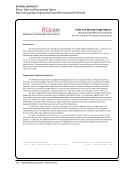74 · Survey Results: Survey Questions and Responses
A locally created web-based access system is used for the University Curriculum Archive, which is a mix of digitized and
born-digital content.
Archival electronic records both via file system server and DSpace.
Archive-It serves as a commercial repository product for web-archived material. DSpace, and open-source repository
software, is used to provide access to some open materials that can be described at the item level. The rest is managed
via file storage.
Bepress (commercial) used for institutional repository open source plans for Special Collections.
CONTENTdm is used for searching and access. DSpace is used for dark archives (the Institutional Repository).
Currently, two instances of DSpace are used to deliver some born-digital content.
DSpace for thesis and dissertations and some university electronic content a secure limited access sever space for digital
content, such as mpeg movie files, created in MASC digitization projects.
Described above: Archive-It for web archive DSpace for ETDs file system storage for other born-digital special
collections materials.
DSpace for GIS data CONTENTdm for documents, audio, visual materials.
DSpace for ETDs. Shared Shelf for photographs and artworks.
DSpace handles our institutional and subject repositories and is primarily a text and data focused site. UMedia Archive
(Drupal, Fedora) is used to manage and present our rich media and image files.
DSpace is currently used for the output of the university’s research community, e.g., theses and dissertations, datasets.
Islandora, our digital asset management system, is used for all other forms of digital content and will be utilized for
born-digital records too. Archivematica will also be investigated with regards to processing and managing born-digital
content with ICA-AtoM providing access.
DSpace is used as the platform for our institutional repository we will be using a Fedora-based system for our long-term
digital preservation repository.
DSpace is used for our institutional repository CONTENTdm is used for material digitized in the library ICA-AtoM is
used for collected born-digital material.
DSpace is used for traditional digital objects that DSpace usually manages. Everything else is not in DSpace.
DSpace: theses, DTDs. Homegrown: digital photographs, film, etc.
Fedora is used as basis for dark archive for all materials. DSpace is used as repository and for access to mostly textual
materials. Other systems are used for access to images, video, etc. Materials will be stored in Fedora-based repository.
Fedora system used for digital collections and images VuFind -selective content including some e-text
For institutional records we are using OnBase an ECM system. We are still figuring out how to handle personal
materials. OnBase may be our solution, though likely it will not be.
Images in LUNA Insight, documents in DSpace.
Institutional repository.
Manuscript vs. University Records.
A locally created web-based access system is used for the University Curriculum Archive, which is a mix of digitized and
born-digital content.
Archival electronic records both via file system server and DSpace.
Archive-It serves as a commercial repository product for web-archived material. DSpace, and open-source repository
software, is used to provide access to some open materials that can be described at the item level. The rest is managed
via file storage.
Bepress (commercial) used for institutional repository open source plans for Special Collections.
CONTENTdm is used for searching and access. DSpace is used for dark archives (the Institutional Repository).
Currently, two instances of DSpace are used to deliver some born-digital content.
DSpace for thesis and dissertations and some university electronic content a secure limited access sever space for digital
content, such as mpeg movie files, created in MASC digitization projects.
Described above: Archive-It for web archive DSpace for ETDs file system storage for other born-digital special
collections materials.
DSpace for GIS data CONTENTdm for documents, audio, visual materials.
DSpace for ETDs. Shared Shelf for photographs and artworks.
DSpace handles our institutional and subject repositories and is primarily a text and data focused site. UMedia Archive
(Drupal, Fedora) is used to manage and present our rich media and image files.
DSpace is currently used for the output of the university’s research community, e.g., theses and dissertations, datasets.
Islandora, our digital asset management system, is used for all other forms of digital content and will be utilized for
born-digital records too. Archivematica will also be investigated with regards to processing and managing born-digital
content with ICA-AtoM providing access.
DSpace is used as the platform for our institutional repository we will be using a Fedora-based system for our long-term
digital preservation repository.
DSpace is used for our institutional repository CONTENTdm is used for material digitized in the library ICA-AtoM is
used for collected born-digital material.
DSpace is used for traditional digital objects that DSpace usually manages. Everything else is not in DSpace.
DSpace: theses, DTDs. Homegrown: digital photographs, film, etc.
Fedora is used as basis for dark archive for all materials. DSpace is used as repository and for access to mostly textual
materials. Other systems are used for access to images, video, etc. Materials will be stored in Fedora-based repository.
Fedora system used for digital collections and images VuFind -selective content including some e-text
For institutional records we are using OnBase an ECM system. We are still figuring out how to handle personal
materials. OnBase may be our solution, though likely it will not be.
Images in LUNA Insight, documents in DSpace.
Institutional repository.
Manuscript vs. University Records.










































































































































































































